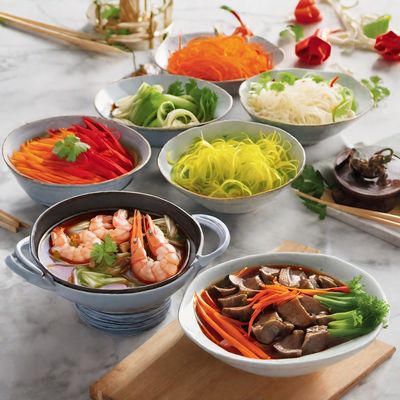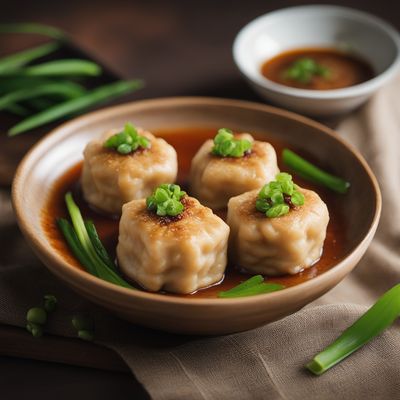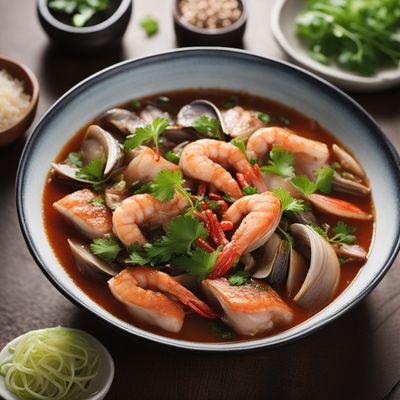
Recipe
Korean-style Hot Pot
Kimchi Hot Pot: A Spicy Twist on a Classic Korean Dish
4.8 out of 5
In Korean cuisine, hot pot, or "jeongol," is a beloved communal dish that brings people together. This Korean-style Hot Pot recipe takes inspiration from the traditional Chinese hot pot and infuses it with the bold flavors of Korean cuisine. With its spicy and tangy broth, fresh ingredients, and interactive cooking experience, this hot pot is sure to warm your soul and delight your taste buds.
Metadata
Preparation time
20 minutes
Cooking time
15 minutes
Total time
35 minutes
Yields
4 servings
Preparation difficulty
Medium
Suitable for
Gluten-free, Dairy-free, Low-carb, High-protein, Pescatarian-friendly
Allergens
Soy, Sesame
Not suitable for
Vegan, Vegetarian, Paleo, Nut-free, Egg-free
Ingredients
While the Chinese hot pot typically features a mild and savory broth, the Korean adaptation adds a fiery kick with the inclusion of kimchi and gochujang, a fermented chili paste. The use of traditional Korean ingredients such as tofu, mushrooms, and thinly sliced beef further distinguishes this hot pot from its Chinese counterpart. We alse have the original recipe for Hot Pot, so you can check it out.
-
4 cups (950ml) beef or vegetable broth 4 cups (950ml) beef or vegetable broth
-
1 cup (235ml) water 1 cup (235ml) water
-
1 cup (200g) kimchi, chopped 1 cup (200g) kimchi, chopped
-
2 tablespoons gochujang (Korean chili paste) 2 tablespoons gochujang (Korean chili paste)
-
1 tablespoon soy sauce 1 tablespoon soy sauce
-
1 tablespoon sesame oil 1 tablespoon sesame oil
-
1 tablespoon minced garlic 1 tablespoon minced garlic
-
1 tablespoon minced ginger 1 tablespoon minced ginger
-
8 ounces (225g) thinly sliced beef (such as ribeye or sirloin) 8 ounces (225g) thinly sliced beef (such as ribeye or sirloin)
-
8 ounces (225g) firm tofu, cut into cubes 8 ounces (225g) firm tofu, cut into cubes
-
4 ounces (115g) enoki mushrooms 4 ounces (115g) enoki mushrooms
-
4 ounces (115g) shiitake mushrooms, sliced 4 ounces (115g) shiitake mushrooms, sliced
-
1 cup (150g) sliced carrots 1 cup (150g) sliced carrots
-
1 cup (150g) sliced zucchini 1 cup (150g) sliced zucchini
-
4 green onions, cut into 2-inch (5cm) pieces 4 green onions, cut into 2-inch (5cm) pieces
-
2 cups (470ml) cooked rice 2 cups (470ml) cooked rice
-
Optional toppings: sliced chili peppers, sesame seeds, chopped cilantro Optional toppings: sliced chili peppers, sesame seeds, chopped cilantro
Nutrition
- Calories (kcal / KJ): 320 kcal / 1340 KJ
- Fat (total, saturated): 15g, 4g
- Carbohydrates (total, sugars): 15g, 5g
- Protein: 30g
- Fiber: 4g
- Salt: 2g
Preparation
-
1.In a large pot, combine the beef or vegetable broth, water, kimchi, gochujang, soy sauce, sesame oil, minced garlic, and minced ginger. Bring to a boil over medium heat.
-
2.Reduce the heat to low and let the broth simmer for 10 minutes to allow the flavors to meld together.
-
3.Add the thinly sliced beef to the pot and cook for 1-2 minutes until it is no longer pink.
-
4.Add the tofu, enoki mushrooms, shiitake mushrooms, carrots, zucchini, and green onions to the pot. Cook for an additional 5 minutes until the vegetables are tender.
-
5.Serve the hot pot with cooked rice on the side. Optionally, garnish with sliced chili peppers, sesame seeds, and chopped cilantro.
Treat your ingredients with care...
- Kimchi — Use well-fermented kimchi for a more intense flavor.
- Gochujang — Adjust the amount of gochujang according to your spice preference.
- Beef — For best results, freeze the beef for 30 minutes before slicing it thinly.
- Tofu — Use firm tofu to prevent it from breaking apart during cooking.
- Mushrooms — Feel free to experiment with different types of mushrooms for added variety.
Tips & Tricks
- To enhance the flavor of the broth, you can add a dash of fish sauce or a splash of rice wine.
- Customize your hot pot by adding other ingredients such as seafood, dumplings, or noodles.
- If you prefer a milder spice level, reduce the amount of gochujang or omit the chili peppers.
- Don't overcook the vegetables to retain their crispness and vibrant colors.
- Leftover hot pot can be refrigerated and enjoyed as a delicious soup the next day.
Serving advice
Serve the Korean-style Hot Pot as a centerpiece on the dining table. Each person can add their desired ingredients to the pot and cook them to their liking. Encourage guests to enjoy the hot pot with a bowl of steamed rice on the side.
Presentation advice
Present the hot pot in a large, colorful pot or a traditional Korean earthenware pot called "dolsot." Garnish with sliced chili peppers, sesame seeds, and chopped cilantro for an appetizing and vibrant presentation.
More recipes...
For Hot Pot » Browse all
For Chinese cuisine » Browse all
More Chinese cuisine dishes » Browse all

Cantonese Slow-Cooked Soup
Shark Fin Soup
Cantonese Slow-Cooked Soup is a traditional Chinese soup that is slow-cooked for several hours to extract the flavors and nutrients from the ingredients.

Chicken with Walnuts
This dish is a classic Chinese recipe that combines tender chicken with crunchy walnuts and a sweet and savory sauce. It's perfect for a special...

Hot and Sour Soup
Hot and sour soup is a popular Chinese soup that is known for its spicy and tangy flavor. It is made with a variety of ingredients, including...
More Korean cuisine dishes » Browse all

Dalgona Candy
Dalgona Candy is a traditional Korean candy that has become popular all over the world. The candy is made by mixing sugar, baking soda, and water...

Kkaennip-jeon
Kkaennip-jeon is a Korean dish made from perilla leaves that are coated in a batter and then pan-fried. It is a popular appetizer or side dish and...

Jaengban guksu
Jaengban Guksu
Jaengban guksu is a Korean cold noodle dish that is perfect for hot summer days. It is made with thin wheat noodles, a variety of vegetables, and...










